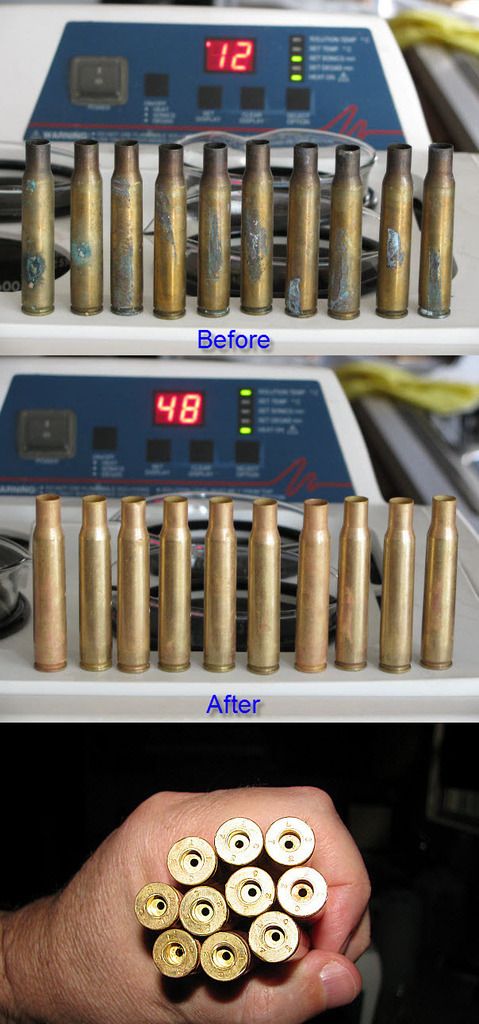Steel shot of any kind is too heavy for a vibratory tumbler and will effectively stall it if it isn't a high power commercial unit costing several times what one sold for brass cleaning does. The round shot shape will never get into the inside corners of a primer pocket, either, which is why the stainless steel pin method uses straight pins. But a rotary tumbler is needed for that.
ms6852 said:
I use the hornady ultrasonic cleaner the big one, and water and distilled vinegar with some soap and than stop the reaction with baking soda.
Allow me to make a recommendation:
If you look at Hornady's One Shot cleaner,
its MSDS reveals it is basically a citric acid solution, possibly with a wetting agent similar to dishwashing detergent or other surfactant added in. The fact it is green is due to a dye of some kind added to help you identify it. Pure citric acid solutions are clear.
Citric acid, unlike vinegar, has a self-limiting reaction on brass and copper that leaves the surface passivated, so you don't get the oxide color staining over time that vinegar produces, plus there is no need to neutralize it. Just a water rinse is needed. Indeed, citric acid solution is used as a treatment by brass manufacturers for pieces that are to be stored for a long time, because that passivation prevents corrosion. The yellow darkens a little over time, but that's it.
The Hornady MSDS lists its One Shot brass cleaning concentrate as less than 30% citric acid. They then have you dilute it 40:1 for use. This means they have something under 0.75% citric acid in the working solution. Citric acid is cheap. You can get
10 lbs for $25 postage paid. That will make 120 gallons of 0.75% working strength solution for $0.21/gallon, instead of paying $1.50/gallon buying Hornady's solution. You can add a few drops of dishwashing liquid to help remove oil from the brass surface and suspend dirt, though citric acid softens water and makes it slippery already and you may find this unnecessary.
The old Frankford Arsenal (pre-1920's; when it was still an actual government arsenal) case cleaner formula was 5% citric acid, but that was in a vat and not an ultrasonic cleaner. It's more than you need for just one shot of cleaning and makes you throw away a lot unused if you don't reuse it. Nonetheless, knowing no better, I used that 5% solution in my heated ultrasonic cleaner when I first tried it. Here's how it worked on some badly corroded brass that had been in a broken plastic bag that was flooded with water:

Note the brass is yellow, but not mirror polished in any way. I find it is actually more visible in grass this way than when polished because the matte surface doesn't mirror grass blades or other textures around it, but just stands out as a yellow object. YMMV, but I once made the mistake of using nickel-plated brass in a match, figuring it would be quicker to tell my cases from other people's. Wrong. Quicker to lose them. The polished white metal surface mirrored grass with such fidelity it became invisible and I lost more cases than when other people walked off with them by mistake. Live and learn.
If you want a polished surface, once the brass has been cleaned in citric acid, as above, just tumble with corncob or walnut. Have a little ammonia-free brass polish in it, too, if you want to. It polishes pretty fast in the Green Lyman corncob and a vibratory tumbler. 15 min-30 min, depending on the age of the media. I did this to the brass in photo after the photo was taken because of the pink spots left where the corrosion that had preferentially attacked the zinc in the surface brass was removed, leaving copper color. The copper color came right off during polishing.

